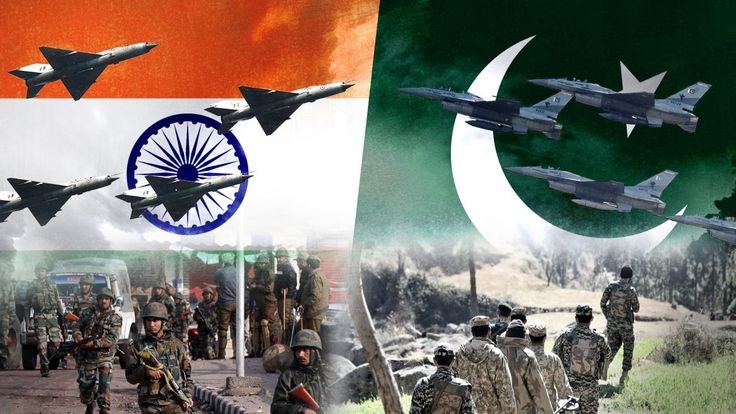
India–Pakistan Relations: History, Conflicts & Current Diplomatic

Explore the history of India–Pakistan relations, from partition and wars to current diplomatic tensions. Learn about key conflicts, peace efforts, and the status in 2025.The diplomatic relations between India and Pakistan are complex and often tense. Here’s a brief overview:
1. Historical Background
- India and Pakistan were created in 1947 after the partition of British India.
- Since then, they have fought three major wars (1947, 1965, 1971) and a conflict in Kargil (1999), mostly over the disputed region of Kashmir.
2. Diplomatic Status
- Both countries maintain embassies in each other’s capitals (New Delhi and Islamabad), but diplomatic ties have gone through many ups and downs.
- Dialogue processes like “Composite Dialogue” and “Track II diplomacy” have been attempted multiple times but often stall after terror attacks or military incidents.
3. Key Issues
- Kashmir dispute remains the core issue.
- Terrorism: India accuses Pakistan of supporting cross-border terrorism.
- Water sharing, trade, and prisoner exchanges are also points of contention and occasional cooperation.
4. Recent Developments
- Relations worsened after the 2016 Uri attack, 2019 Pulwama attack, and India’s abrogation of Article 370 (ending Kashmir’s special status).
- There have been periods of low-level dialogue or backchannel talks, but no sustained peace process recently.
5. International Mediation
- While some countries offer to mediate, India generally insists on bilateral resolution, whereas Pakistan is more open to international involvement.
In summary, the relationship is highly strained, with limited engagement and deep mistrust, although both sides occasionally show willingness to improve ties under the right conditions.
Would you like a timeline of major events in India-Pakistan relations?
The diplomatic relations between India and Pakistan are complex and often tense. Here’s a brief overview.
Certainly! Here’s a more detailed look at the diplomatic relationship between India and Pakistan, including specific areas of conflict, attempts at peace, and current status:
🔥 Major Conflicts
- 1947–48 War: Over Jammu and Kashmir after the princely state acceded to India. Ended with a UN-mediated ceasefire, creating the Line of Control (LoC).
- 1965 War: Full-scale war again over Kashmir. Ended with the Tashkent Agreement, mediated by the Soviet Union.
- 1971 War: Resulted in the creation of Bangladesh (formerly East Pakistan). Led to the Simla Agreement in 1972, emphasizing peaceful resolution and bilateral talks.
- 1999 Kargil Conflict: Pakistani soldiers and militants infiltrated Indian positions in Kargil (Ladakh). India repelled them; tensions escalated again.
🕊️ Peace Efforts
- Simla Agreement (1972): After the 1971 war, both agreed to resolve issues peacefully and bilaterally.
- Lahore Declaration (1999): PMs Nawaz Sharif and Atal Bihari Vajpayee agreed to reduce tensions and build trust. But the Kargil War occurred shortly after.
- Agra Summit (2001): A summit between Indian PM Vajpayee and Pakistani President Musharraf ended without agreement.
- Composite Dialogue Process (2004–2008): Covered all major bilateral issues including Kashmir, terrorism, and trade. Ended after the 2008 Mumbai terror attacks.
⚠️ Terrorism and Cross-Border Tensions
- 2001 Indian Parliament attack: Blamed on Pakistan-based groups; nearly led to war.
- 2008 Mumbai attacks: 166 people killed. India blamed Lashkar-e-Taiba, a Pakistan-based group. Diplomatic relations soured deeply.
- 2016 Uri attack & 2019 Pulwama attack: India accused Pakistani terrorists; both led to military escalations, including India’s Balakot airstrike.
🛑 Current Status (as of 2025)
- No full diplomatic engagement; High Commissioners are present, but dialogue is minimal.
- Trade is suspended, except for some indirect exchanges.
- People-to-people contact (visas, tourism, cultural exchange) is extremely limited.
- Occasional backchannel talks reported, but no breakthroughs.
- Both countries continue to exchange strong statements in international forums like the UN.
🕵️ Other Important Aspects
- Nuclear Powers: Both countries are nuclear-armed, making conflict especially dangerous.
- China’s role: China is an ally of Pakistan and a rival to India, adding complexity.
- International pressure: Countries like the US, UAE, and others often push both sides toward peace.
In short, India-Pakistan relations remain highly volatile, with deep-rooted mistrust, but potential for improvement exists if both governments commit to dialogue and peace.
1. What is the main reason for conflict between India and Pakistan?
The primary reason is the territorial dispute over Jammu and Kashmir, which both countries claim in full but control in parts. Other issues include cross-border terrorism, water sharing, and historical tensions from the 1947 partition.
2. How many wars have India and Pakistan fought?
India and Pakistan have fought four major conflicts:
Kargil Conflict (1999)
First Kashmir War (1947–48)
Second Kashmir War (1965)
Indo-Pak War leading to Bangladesh’s creation (1971)
3. What is the Simla Agreement?
The Simla Agreement, signed in 1972, is a bilateral treaty that emphasizes peaceful resolution of issues through direct dialogue, especially after the 1971 war.
4. What is the current status of India–Pakistan relations?
As of 2025, relations remain tense, with minimal diplomatic contact, no formal dialogue, and suspended trade. Occasional backchannel talks and military confidence-building measures continue.
5. Have India and Pakistan ever tried to improve relations?
Yes. Several peace efforts include the Lahore Declaration (1999), Agra Summit (2001), and the Composite Dialogue Process (2004–2008), though most were derailed by terror attacks or political changes.
6. Is Kashmir still a disputed region?
Yes. Kashmir remains a heavily militarized and disputed territory, with both nations controlling parts of it and claiming it in full. India revoked Article 370 in 2019, changing Kashmir’s status, which Pakistan strongly opposed.



